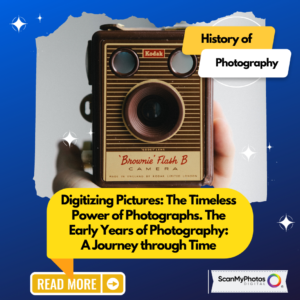Preserving history and photo memories is the topic of today’s PICTURE THIS!
 In today’s fast-paced digital world, capturing and sharing moments through photographs have become integral to our daily lives. From the rise of smartphone photography to the proliferation of social media platforms, it seems like the art of photography has never been more accessible and prevalent.
In today’s fast-paced digital world, capturing and sharing moments through photographs have become integral to our daily lives. From the rise of smartphone photography to the proliferation of social media platforms, it seems like the art of photography has never been more accessible and prevalent.
But long before the advent of Kodak and George Eastman’s revolutionary contributions to photography, people already recognized the profound emotional power of capturing memories through images.
The Early Years of Photography: A Journey through Time
Photography dates back to ancient civilizations. People experimented with various image-capture methods. However, in the early 19th century, breakthroughs in photographic technology began to emerge. Visionaries like Louis Daguerre and William Henry Fox Talbot developed daguerreotype* and calotype processes, respectively, allowing tangible photographs to be created. [*Daguerreotype: a photograph taken by an early photographic process employing an iodine-sensitized silvered plate and mercury vapor].
Moreover, in the decades that followed, photography slowly made its way into the lives of the masses. With the accelerated growth of digitalization, photography has become a significant part of our everyday lives. The emergence of smartphone photography and the extensive usage of social media outlets has made capturing moments simpler than ever before. Yet, the concept of recording memories through photos is nothing new, even before George Eastman and Kodak changed the landscape of photography with their groundbreaking innovations. People have always known of its emotional impact.
The ability to freeze a moment in time and preserve it for posterity resonated deeply with people, and the emotional value of photographs became apparent. Families cherished portraits of their loved ones, while explorers and travelers documented their adventures to share with the world.
Kodak’s Impact and Beyond: The Era of Snapshot Photography
Furthermore, the turning point in photography came with the founding of the Eastman Kodak Company by George Eastman in the late 19th century. Eastman’s vision was to make photography accessible to all. In 1888, he introduced the Kodak camera.
It was a simple handheld device that came preloaded with film. This invention revolutionized photography, making it more user-friendly and affordable for the general public.
With the popularization of snapshot photography, capturing everyday moments became widespread. From family gatherings to vacations, people started documenting their lives more frequently. The emotional resonance of photographs strengthened as they became windows into the past, allowing people to revisit cherished memories and relive significant moments.
The Digital Age: A New Frontier in Photography
As technology advanced, so did photography. The transition from analog to digital cameras in the late 20th century marked another turning point in the art form’s evolution. Digital photography made capturing and sharing images easier and opened up new possibilities for editing and enhancing photographs.
With the rise of digital photography, the demand for photo printing decreased, and physical photo albums gave way to digital galleries and cloud storage. As a result, many precious memories ended up locked away in the form of film negatives, 35mm slides, home movie reels, and printed pictures.
<< Digitize My Pictures Now! >>
Preserving the Past: The Importance of Digitization
In an era where memories are often stored in the cloud or on social media platforms, physical photographs and film reels risk fading away, becoming inaccessible or lost forever. This is where the vital role of digitization services like ScanMyPhotos, comes into play.
Digitization services bridge the gap between the analog past and the digital present. Individuals and families can preserve their visual heritage by converting old photos, film negatives, and slides into digital formats. This process not only ensures that these memories remain safe and easily accessible but also provides an opportunity for restoration and enhancement, breathing new life into fading photographs.
Conclusion: Honoring the Emotional Legacy
Photographs have always held immense emotional power, transcending time and space to evoke feelings of nostalgia, love, and connection. From the early experiments with photography to the snapshot revolution brought about by Kodak, and now into the digital age, the essence remains unchanged – photographs are windows to our past and a way to treasure the moments that define us.
As we move forward, it is crucial to honor the legacy of our visual heritage by digitizing and preserving these precious memories. Scanning experts like ScanMyPhotos offer a gateway to the past, ensuring that the emotional power of photographs endures for generations to come. So, let us celebrate the timeless art of photography and embrace the journey of preserving our memories in the ever-changing landscape of technology.



